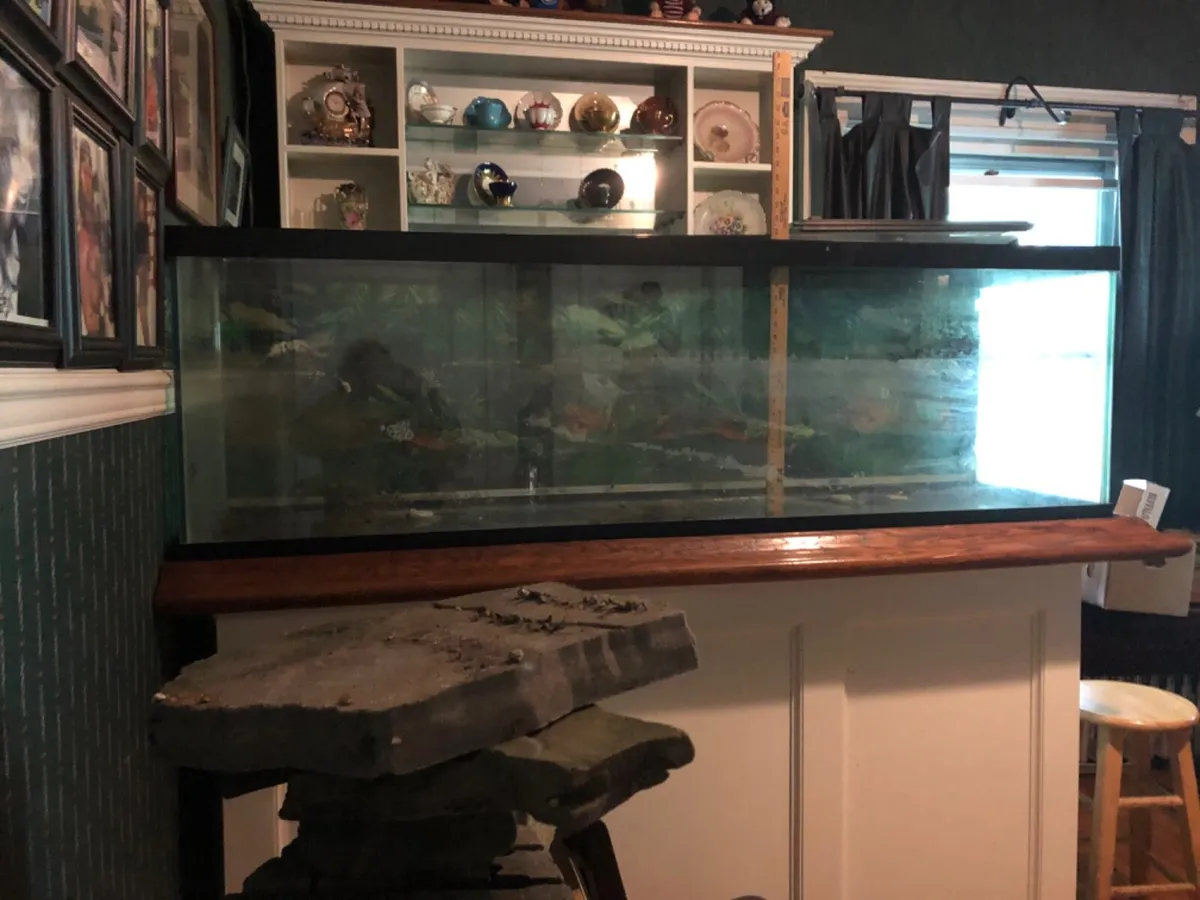
Choosing a 125 Gallon Turtle Tank: What to Consider
The filtration system is another crucial consideration. Turtles are messy creatures and produce a lot of waste, so a high-quality filtration system is essential to keep the water clean and healthy for your pets. Look for a filtration system that can handle the size of the tank and effectively remove impurities and toxins.
In addition to filtration, heating and lighting are also important considerations. Turtles require a basking area with a heat lamp to regulate their body temperature, as well as UVB lighting to help them synthesize vitamin D. A 125-gallon tank should have adequate space for these essential heat and light sources.
Accessibility and cleaning are other factors to consider. A tank that is easy to access and clean will make caring for your turtles much easier. Look for tanks with removable tops or access points that allow you to reach all areas of the tank without difficulty.
Last but not least, consider the aesthetics and décor of the tank. While turtles may not be as concerned with the appearance of their tank, choosing one that fits well with your home’s style can make it a more enjoyable part of your living space. Consider adding natural-looking rocks, plants, and hiding spots to create a visually appealing and stimulating environment for your turtles.
Choosing the Right 125 Gallon Turtle Tank for Your Pet
Tank Size and Dimensions
A 125-gallon tank typically measures around 72 inches in length, 18 inches in width, and 24 inches in height. These dimensions offer a wide swimming area and sufficient depth for your turtle to dive and explore. Additionally, the length of the tank allows for the installation of various accessories and basking spots, creating a more enriched environment for your turtle.
Material and Durability
When choosing a 125-gallon turtle tank, it is essential to select a tank made from sturdy and durable materials. The tank should be made from high-quality glass or acrylic to ensure that it can withstand the water pressure and the activities of your turtle. Glass tanks provide better visibility, while acrylic tanks are more lightweight and less prone to cracking.
Additionally, consider the thickness of the tank walls. Thicker walls provide better insulation and are less likely to break or crack. It is also important to choose a tank with reinforced corners or edges to add extra durability.
Filtration System
A proper filtration system is crucial for maintaining clean water in your 125-gallon turtle tank. Turtles produce a significant amount of waste, and a reliable filtration system is necessary to remove debris, chemicals, and other contaminants from the water.
When choosing a filtration system for your tank, consider a combination of mechanical, biological, and chemical filtration. A canister filter is often recommended for large turtle tanks as it offers efficient filtration and ample capacity. Additionally, consider the flow rate of the filter, ensuring that it can effectively circulate and filter the water in the tank.
Conclusion
Choosing the right 125-gallon turtle tank involves considering various factors such as tank size, dimensions, material, and filtration system. Providing your turtle with a spacious and suitable habitat will ensure their overall well-being and enjoyment. Proper care and maintenance of the tank will create a healthy and thriving environment for your pet turtle.
Choosing the Right Material and Durability for Your 125 Gallon Turtle Tank
There are several materials commonly used for turtle tanks, including glass, acrylic, and plastic. Each material has its own advantages and considerations.
Glass Tanks
Glass tanks are a popular choice for turtle owners due to their sleek appearance and clarity. They provide excellent visibility, allowing you to observe your turtles from various angles. Glass tanks are also scratch-resistant, which is essential as turtles can sometimes try to climb the tank walls.
Acrylic Tanks
Acrylic tanks offer many advantages, such as being lightweight, durable, and less likely to break compared to glass tanks. They are also available in various shapes and sizes, allowing you to customize the tank to suit your needs.
Plastic Tanks
Plastic tanks are generally the most affordable option and are suitable for smaller turtle species. They are lightweight, easy to clean, and less likely to break compared to glass or acrylic tanks.
However, plastic tanks are not as aesthetically pleasing and may not be as durable as glass or acrylic tanks. They can warp or become discolored over time, especially if exposed to direct sunlight or high temperatures. Consider plastic tanks for temporary or budget-friendly setups rather than long-term housing for your turtles.
Choosing the Right Filtration System for Your Turtle Tank
Filtration Types
There are several types of filtration systems available for turtle tanks, each with its own advantages and disadvantages.
| Filtration Type | Advantages | Disadvantages |
|---|---|---|
| Canister Filters | – Excellent filtration efficiency – Suitable for larger tanks |
– Higher initial cost – Can be bulky and take up space |
| Hang-On-Back Filters | – Easy to install and maintain – Cost-effective |
– Less efficient in larger tanks – Can be noisy |
| Internal Filters | – Compact and space-saving – Easy to hide in the tank |
– Limited filtration capacity – Need frequent cleaning |
Filtration Capacity
The rule of thumb is to choose a filter with a capacity of at least 2-3 times the size of your tank. For a 125 gallon turtle tank, a filtration system with a capacity of 250-375 gallons per hour (GPH) is recommended.
Additional Features
Some filtration systems may have additional features that can enhance the functionality and convenience of the tank. These features may include:
- Adjustable flow rate
- Media baskets for customizable filtration
- Built-in UV sterilizers
- Self-priming capabilities
Consider these additional features based on your specific needs and preferences.
Heating and Lighting
First and foremost, you need to choose a suitable heating source for your tank. This can be achieved using a combination of a basking light and a heating pad. The basking light should mimic the natural sunlight that turtles need for their metabolism and vitamin D synthesis. It should be positioned over a basking area, allowing the turtle to regulate its body temperature by moving closer to or further away from the light.
In addition to the basking light, a heating pad can be placed under one side of the tank to provide a warm area for your turtle to retreat to when it needs to warm up. This is especially important during cooler months or for turtles that require higher temperatures. Make sure to monitor the temperature regularly using a reliable thermometer to ensure it stays within the appropriate range for your specific turtle species.
Next, you should also consider the lighting requirements for your turtle tank. Turtles need access to UVB light in order to produce vitamin D3, which is crucial for their calcium metabolism and overall health. UVB rays cannot penetrate glass or plastic, so it is necessary to provide a UVB light source within the tank.
Turtle Tanks: Accessibility and Cleaning for a 125 Gallon Tank
Consider the Size and Dimensions
Access Points and Cleaning Procedures
When selecting a 125-gallon turtle tank, pay attention to the number and size of access points available. It’s recommended to choose a tank with multiple hinged or sliding doors that provide easy entry to the tank’s interior. Additionally, ensure the tank’s lid or top opening is large enough to allow for full access when cleaning or performing maintenance tasks.
Choosing the Right Cleaning Supplies
In addition to cleaning solutions, consider investing in appropriate cleaning tools such as algae scrapers, brushes, and siphons. These tools will help you effectively remove algae, debris, and waste from the tank walls, decorations, and substrate. Regular cleaning and maintenance will also reduce the risk of bacterial and fungal growth, ensuring a clean and healthy habitat for your turtle.
Conclusion
When choosing a 125-gallon turtle tank, accessibility and cleaning are important factors to consider. By selecting a tank with adequate access points and adopting a regular cleaning routine, you can provide your turtle with a clean and safe habitat. Remember to choose turtle-safe cleaning supplies and tools to maintain the overall health and well-being of your beloved pet.
Aesthetics and Décor
Add a Natural Touch
One of the best ways to enhance the aesthetics of your 125-gallon turtle tank is by adding a natural touch to the décor. Consider including natural substrates like sand or gravel to mimic the environment of a turtle’s habitat. This not only provides a visually pleasing look but also allows your turtle to engage in natural behaviors like burrowing and digging.
Additionally, you can add live or artificial plants to the tank. Live plants add beauty to the enclosure and also provide hiding spots and climbing areas for your turtle. Artificial plants can be easier to maintain and still provide a naturalistic look.
Create a Safe and Stimulating Environment
Furthermore, consider adding various types of enrichment items to keep your turtle mentally and physically stimulated. This can include floating toys, basking platforms, or interactive feeding devices. These additions not only make the tank more visually appealing but also create an engaging environment for your turtle’s overall well-being.
Maintain a Clean and Organized Tank

To maintain the aesthetics of your 125-gallon turtle tank, it is essential to keep it clean and organized. Regularly remove any uneaten food, waste, or debris from the tank to prevent water quality issues and foul odors.
Keep the tank well-maintained by performing regular water changes and filter cleanings. This helps to ensure crystal-clear water, preserving the overall aesthetic appeal of the tank. Additionally, maintaining proper water temperature and lighting conditions is crucial for both the health of your turtle and the visual appeal of the tank.

I’m Lena Adams—a product of an unconventional upbringing in the African wilderness. My father, a daring explorer of African wildlife, sparked my fascination with reptiles, a passion that intertwined with the tragic loss of my mother during an expedition, leaving an indelible mark on my life. Driven to understand the creatures that captivated my parents, I embarked on my journey, sharing insights about reptiles, frogs, and lizards on my website. Through my explorations and conservation efforts, I honour my family’s legacy while seeking connections—to the creatures, nature, and the mother whose presence I yearn to understand.
